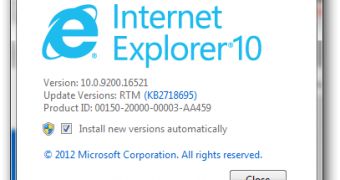Microsoft has just released the final version of Internet Explorer 10 for Windows 7, so the company most likely expects the majority of users to make the move to the latest build of its in-house browser.
System requirements are pretty important, however, when it comes to such an update, especially since the preview version of IE10 for Windows 7 was often criticized for slowing down computers.
The final version of the browser is obviously supposed to provide a full browsing experience, so you shouldn’t experience any slowdown or errors while using it, but feel free to use the comment section below to tell us about the issues or bugs that you may discover in IE10 for Windows 7.
Of course, this new build works just fine on both x64 and x86 versions of Windows 7, but keep in mind that Service Pack 1 is required in order to be allowed to install it. As always, we strongly recommend to create a restore point before proceeding with the IE10 installation.
As for the system requirements, here are all of them, as provided by Microsoft:
Processor: Computer with a 1 gigahertz (GHz) 32-bit (x86) or 64-bit (x64) processor.
Operating system
• Windows 7 32-bit with Service Pack 1 (SP1) or higher • Windows 7 64-bit with Service Pack 1 (SP1) or higher • Windows Server 2008 R2 with Service Pack 1 (SP1) 64-bit
Memory
• Windows 7 32-bit—512 MB • Windows 7 64-bit—512 MB • Windows Server 2008 R2 64-bit—512 MB
Hard drive space
• Windows 7 32-bit—70 MB • Windows 7 64-bit—120 MB • Windows Server 2008 R2 64-bit—200 MB
Drive: CD-ROM drive (if installation is done from a CD-ROM)
Display: Super VGA (800 x 600) or higher-resolution monitor with 256 colors
Peripherals
• Modem or Internet connection • Microsoft Mouse, Microsoft IntelliMouse, or compatible pointing device

 14 DAY TRIAL //
14 DAY TRIAL //